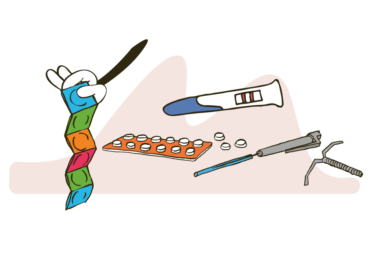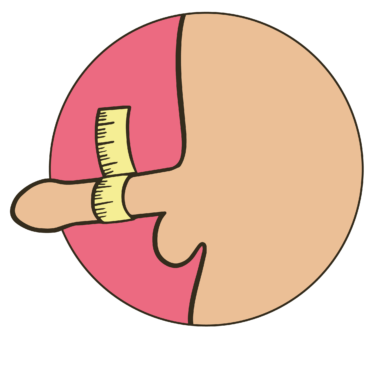Jump directly to the individual STIs to learn more:
Chlamydia
Pathogen
Bacterium: Chlamydia trachomatis.
Type of test
Chlamydia tests are usually done by swabbingA swab can be taken from various organs, usually mucous membranes (e.g. vagina, throat, urethra). A vaginal smear test is routinely carried out when you visit a gynecologist. Skin cell material is taken using a swab in order to detect any c... the cervixThe cervix is the connection between the vagina and the uterus. At the front of the cervix is the cervix. or penile urethraUrine from the bladder is excreted from the body via the urethra. In the vulva, the urinary outlet is located between the clitoral pearl and the vaginal entrance. In the penis, the urethra leads through the penis to the tip of the glans.. There are also urine-based tests that can be used in some cases.
Routes of infection
Chlamydia can be transmitted during vaginal, anal or oral sexOral sex or oral intercourse is a sexual activity in which the aim is to give each other sexual pleasure by stimulating erogenous zones with the mouth (and throat area). This includes stimulation with the tongue, mouth and lips. See also cu.... It can also be transmitted from mother to child during childbirthAnother word for the birth of a child..
Symptoms
Many people with chlamydia have no symptoms. If symptoms do occur, they may appear a few weeks after infectionHaving an infection or being infected means that you have contracted a pathogen. This can be a flu, herpes or HI virus, for example. and include pain or burning when urinating, unusual dischargeDischarge is always a sign that something is wrong. However, various fluids and secretions come out of the vagina from different glands. A clear or white to yellowish fluid, known as cervical mucus, tells you where you are in your cycle, fo... from the vaginaobsolete word for vagina. or penisPenis is another name for the penis and, together with the scrotum, is one of the external male sex organs. The penis consists of the shaft and the glans. The glans is the most sensitive part of the male body and is covered by a foreskin, u... and pain in the lower abdomen.
Treatment
Chlamydia can be treated with antibiotics. It is important to complete the full course of treatment to ensure that the infection is completely cured. Sexual partners should also be tested and treated for chlamydia to prevent re-infection.
Dangerousness
Chlamydia is one of the most common STIs and its prevalence has unfortunately been increasing since the noughties. If left untreated, chlamydia can lead to serious health problems such as infertilityA foreign word for infertility.. Timely treatment is therefore important to avoid complications. This is why it is important to get tested regularly for chlamydia.
Is there a vaccination?
There is currently no vaccination against chlamydia.
HIV
Pathogen
Virus: The human immunodeficiency virusHIV stands for "Human Immunodeficiency Virus", which means "human immunodeficiency virus". HIV is a virus that weakens the immune system and can lead to AIDS. You can contract HIV by having unprotected sex, getting blood from someone with H... (HIVHIV stands for "Human Immunodeficiency Virus", which means "human immunodeficiency virus". HIV is a virus that weakens the immune system and can lead to AIDS. You can contract HIV by having unprotected sex, getting blood from someone with H...)
Type of test
HIV testing can be done either through a blood sample, a urine sample or a cheek swab. The test is based on the detection of antibodies against the virus or on the direct detection of HIV.
Routes of infection
HIV can be transmitted through unprotected sexSex is an intimate activity between two or more people who share physical closeness. Sex can be practiced in different ways, depending on the preferences and desires of the people involved. The only rule that always applies: sex without mut... (vaginal, anal or oral), sharing syringes, blood transfusions with infected blood, from an infected mother to her child during pregnancyPregnancy is the time between the fusion of sperm and egg and the birth of the baby, which normally lasts around 9 months. The first sign of pregnancy is the absence of menstrual bleeding, which would otherwise occur regularly., childbirth or breastfeeding.
Symptoms
- Acute symptoms: 2-4 weeks after infection, flu-like symptoms such as fever, headache, skin rash, swollen lymph nodes and fatigue may occur.
- Chronic symptoms: HIV damages the immune system over time, which can lead to symptoms such as chronic fatigue, night sweats, weight loss and persistent diarrhea. Other symptoms may include: skin conditions, fungal infectionsHaving an infection or being infected means that you have contracted a pathogen. This can be a flu, herpes or HI virus, for example., fever, chills and swollen lymph nodes.
Treatment
There is no cure for HIV, but there are drugs that can keep the virus under control. Antiretroviral therapy (ART) can slow the spread of the virus in the body and strengthen the immune system. ART can reduce the viral load to a very low level so that people with HIV can lead a normal life. ART must be taken every day exactly as directed.
Dangerousness
HIV is still the most dangerous STISTI is the abbreviation for "sexually transmitted infections". Sometimes only the abbreviation STI is used in specialist circles or in brochures. because it weakens the immune system and can lead to life-threatening illnesses. Without treatment, HIV can lead to AIDSAIDS is the abbreviation for Acquired Immunodeficiency Syndrome. HIV is a virus that damages the immune system and thus impairs the body's ability to protect itself against infections and diseases. If the HIV virus spreads in the body and t... (Acquired Immunodeficiency Syndrome). This is a disease that weakens the immune system and makes the body susceptible to infections and diseases. Diseases that can normally be easily combated, but with AIDS lead to death.
Syphilis
Pathogen
Bacterium: Treponema pallidum
Type of test
SyphilisSyphilis is a sexually transmitted infection (STI) caused by bacteria. It can lead to ulcers and tissue damage in various parts of the body if it is not detected and treated early. tests can be carried out using a blood sample or a swab from ulcers. The test is based on the detection of antibodies against the bacterium or on the direct detection of Treponema pallidum.
Routes of infection
Syphilis can be transmitted through unprotected vaginal, anal or oral sex, during pettingPetting is a form of physical intimacy between two people with selective touching, kissing and cuddling. Petting is a very intimate and beautiful way to be close to each other. The boundary to sex is not clear. It is usually understood to m..., kissingA kiss is a form of physical intimacy in which two people press their lips together to express feelings such as affection, passion or friendship. There are different types of kisses such as the hand kiss, cheek kiss, French kiss and so on. ... and sex toyThis includes all objects that can be used alone or with others to give pleasure and/or sexual satisfaction, such as vibrators, pleasure balls, cock rings, sex dolls, masturbators, dildos, vaginal replicas, whips, paddles, swings and many m... sharing and close skin contact with infected ulcers or from an infected mother to her baby during pregnancy, childbirth or breastfeeding.
Symptoms
Syphilis progresses in different stages: Primary syphilis: 2-4 weeks after infection, a painless ulcer forms at the site of infection, usually on the genitalsThis is the medical term for sexual organs. This refers to both the internal and external sexual organs. The external genitalia penis, scrotum and testicles are referred to as male genitalia. The vulva is referred to as the female genitalia..., anusAnus (also called anus) refers to the exit opening of the large intestine. Colloquially also called "asshole". or in the mouth. Secondary syphilis: 4-10 weeks after infection, symptoms such as rash, fever, fatigue and swollen lymph nodes may occur. Latent syphilis: Without treatment, the infection goes into a symptom-free phase, which can last from weeks to years. Tertiary syphilis: Without treatment, syphilis can lead to serious health complications such as damage to the bones, nervous system, heart and other organs.
Treatment
Syphilis can be treated with antibiotics such as penicillin. Depending on the stage of the infection, different lengths of treatment may be required. It is important that all sexual partners are tested and treated if necessary.
Dangerousness
If syphilis is left untreated, it can lead to serious health complications, which in some cases can even be fatal. In pregnant women, syphilis can also cause miscarriageIs the medical term for miscarriage. or infection of the unborn child.
Hepatitis A
Pathogen
Virus: HepatitisHepatitis is a disease that attacks the liver. There are different types of hepatitis, such as hepatitis A, B and C. Symptoms can include fatigue, yellowing of the skin and eyes, nausea and pain in the abdomen. There are vaccines and medica... A virus (HAV)
Type of test
Blood test for the detection of antibodies against HAV
Routes of infection
Fecal-oral contact, contaminated water and food, direct contact with infected persons.
How can you protect yourself?
Good hygieneHygiene refers to keeping the body and the environment clean and healthy. This includes regular washing, e.g. of the genital area to remove germs and bacteria. A healthy diet and sufficient sleep also contribute to good hygiene., regular hand washing, safe food and water sources, vaccination
Symptoms
Fatigue, fever, nausea, abdominal pain, jaundice
Treatment
Supportive therapy, no specific antiviral therapy available
Dangerousness
Usually a self-limiting disease, but can have more serious consequences in older or immunocompromised people.
Is there a vaccination?
Yes, there is a vaccination against hepatitis A.
Hepatitis B
Pathogen
Virus: The hepatitis B virus (HBV)
Type of test
There are various tests to diagnose hepatitis B, including blood tests, antibody and antigen tests and liver function tests. The test is based on the detection of antibodies against the virus or on the direct detection of HBV.
Routes of infection
HBV can be transmitted through vaginal, oral or anal sexA term derived from the Latin word anus (for anus) for sexual intercourse in which the penis is inserted into the anus. The anal region can be a sexually erogenous zone. Not everyone likes anal sex. It is a variant of sexual experience, not..., sharing syringes, contact with infected blood and body fluids such as saliva, urine and semen, from an infected mother to her baby during pregnancy, birthAnother word for the birth of a child. or breastfeeding.
Symptoms
Many people with HBV have no symptoms. Others may experience symptoms such as fatigue, fever, loss of appetite, nausea, vomiting, abdominal pain, dark urine and yellowish skin and eyes. Some people can also develop chronic hepatitis B, which can lead to liver damage, liver cancer and liver failure.
Treatment
There is no cure for hepatitis B, but there are medications that can keep the virus under control and reduce the risk of liver damage and other complications. Antiviral therapy and vaccinations can help prevent or treat the virus.
Dangerousness
HBV is a serious disease that can lead to life-threatening complications, especially in people with chronic hepatitis B. Chronic hepatitis B can lead to liver cirrhosis, liver cancer and liver failure.
How can you protect yourself?
The best way to protect yourself from hepatitis B is to get vaccinated. Another important protective measure is to use condomsAnother term for condom (also called Parisian or rubber). or other barrier methods during sex. It is also important not to share needles or syringes with other people and to pay attention to hygiene to avoid contact with infected blood or bodily fluids.
Is there a vaccination?
Yes, there is a vaccination against hepatitis B.
Hepatitis C
Pathogen
Virus: The hepatitis C virus (HCV)
Type of test
An HCV test is usually performed by taking a blood sample, which is then tested for antibodies against the virus in the laboratory.
Routes of infection
HCV is transmitted through contact with infected blood or urine. Risk factors include sharing syringes or other injection equipment when using drugs, unprotected sex with an infected person.
Symptoms
In most cases, hepatitis C infection does not cause symptoms. If symptoms do occur, they can appear within 2 weeks to 6 months after infection and can include flu-like symptoms such as fatigue, nausea, loss of appetite, abdominal pain and fever. Long-term symptoms can include liver disease such as cirrhosis and liver cancer.
Treatment
There are drugs that can treat HCV. The type of treatment depends on several factors, including the severity of the infection and the health of the person affected. Early diagnosis and treatment can reduce the risk of complications such as cirrhosis and liver cancer.
Dangerousness
HCV is a serious disease that, if left untreated, can lead to complications such as cirrhosis and liver cancer. HCV can also lead to a chronic infection that increases the risk of transmission to others. However, there are medications that can help treat HCV.
How can you protect yourself?
The best way to avoid hepatitis C is to avoid contact with infected blood and bodily fluids, or to use appropriate barriers such as condomsAnother term for condom (also called Parisian or rubber)., latex gloves, or lickingOral sex or oral intercourse is a sexual activity in which the aim is to give each other sexual pleasure by stimulating erogenous zones with the mouth (and throat area). This includes stimulation with the tongue, mouth and lips. See also cu... cloths.
Is there a vaccination?
No, there is no vaccination against hepatitis C.
HPV
Pathogen
Virus: Human papillomavirus (HPV)HPV stands for human papillomavirus. It is a virus that can be transmitted through sexual contact. There are many different types of HPV, some of which are harmless and cause no symptoms, while others can lead to various health problems. So...
Type of test
HPVHPV stands for human papillomavirus. It is a virus that can be transmitted through sexual contact. There are many different types of HPV, some of which are harmless and cause no symptoms, while others can lead to various health problems. So... tests can be performed by swabbing cells from the cervixThe cervix is the opening of the birth canal, which is located at the lower end of the cervix., urethra, penis or anus.
Routes of infection
HPV is transmitted through sexual contact (vaginal, anal or oral). Most sexually active people will be exposed to HPV during their lifetime, but not all will develop symptoms or disease.
Symptoms
Many people with HPV have no symptoms and the virus goes away on its own. In some cases, however, HPV can lead to genital wartsGenital warts are skin lesions that usually appear in the genital area (vulva, vagina, penis, anus) in the form of small warts. They are caused by sexually transmitted viruses (human papillomaviruses, HPV) and are sexually transmitted infec... on the genitalsThis is the medical term for sexual organs. This refers to both the internal and external sexual organs. The external genitalia penis, scrotum and testicles are referred to as male genitalia. The vulva is referred to as the female genitalia..., cervix or anus. Some strains of HPV can also lead to cancer, particularly cervical cancer, but also anal cancer, penile cancer and cancer of the mouth and throat.
Treatment
There is no cure for HPV, but there are treatments for warts and preventative measures against the development of cancer. The HPV vaccine can help reduce the risk of HPV infection, including the strains that can cause cancer.
Dangerousness
HPV is a common STI that in most cases does not cause serious health problems. But certain strains of HPV can lead to cancer, and that makes HPV a potentially dangerous infection. It's important to get tested for HPV regularly and get vaccinated against HPV to reduce the risk of infection and developing cancer.
How can you protect yourself?
The best way to protect yourself from HPV infection is to use condoms during sexual intercourseIt is a technical term for "having sex" and specifically means when a penis penetrates a vagina or a vagina receives a penis. It refers to a sexual encounter between two or more people. In colloquial language, there are various expressions .... Although condoms can reduce the risk of infection, they do not offer complete protection, as HPV can also be transmitted through skin contact and mucous membranes that are not covered by a condomAuch Präservativ genannt. Ein Kondom ist eine schlauchförmige Gummihülle, die über den Penis gestreift wird, um während des Geschlechtsverkehrs eine Barriere zu bilden und so eine Schwangerschaft und/oder die Übertragung von sexuell .... Another important protective measure is the HPV vaccination, which protects against the most common types of HPV.
Is there a vaccination?
Yes The vaccine is usually given in two or three doses and is recommended for all adolescents aged 11 to 14 years. However, it is also possible to be vaccinated up to the age of 26.
Gonorrhea
Pathogen
Bacteria: Neisseria gonorrhoeae
Type of test
PCR test (sample of body fluids, e.g. urine, vaginal secretions or dischargeDischarge is always a sign that something is wrong. However, various fluids and secretions come out of the vagina from different glands. A clear or white to yellowish fluid, known as cervical mucus, tells you where you are in your cycle, fo... from the urethra)
Routes of infection
GonorrheaAn STI (sexually transmitted infection), also known as gonorrhea. It is caused by bacteria and can occur in people of all genders. Symptoms can include itching, pain when urinating or discharge. It is important to get tested and treated if ... is transmitted through contact with infected bodily fluids, especially through unprotected sexual contact. Transmission can also occur through contact with infected mucosal tissue, e.g. through the exchange of sex toysThis includes all objects that can be used alone or with others to give pleasure and/or sexual satisfaction, such as vibrators, pleasure balls, cock rings, sex dolls, masturbators, dildos, vaginal replicas, whips, paddles, swings and many m....
Symptoms
In people with a penis, gonorrhea can cause symptoms such as pain or burning when urinating, purulent or bloody discharge from the penis and pain in the scrotumThe scrotum is a bit like a pouch that surrounds and protects the testicles. It can also contract and collapse to ensure the optimum temperature for spermatogenesis of 34.5°C. If it is too cold, the scrotum contracts so that the testicles ... area. People with vagina may experience symptoms such as pain when urinating, unusual vaginal discharge, bleeding between menstrual periods and pain during sexual intercourse. Gonorrhea can also occur without symptoms in all people.
Treatment
Gonorrhea is usually treated with antibiotics. It is important that all sexual partners who have had unprotected contact with an infected person in the last 60 daysAnother description for period, menstruation, menstrual or monthly bleeding. are also tested and treated.
Dangerousness
If left untreated, gonorrhea can lead to serious complications, such as infertilityA foreign word for infertility., pelvic inflammatory disease and prostatitis. In addition, it can increase the risk of contracting other sexually transmitted infectionsThere are some infections that you can only or mainly contract if you have sex with someone who is infected with them. These can be bacteria, viruses, fungi or parasites. Not all STIs can be transmitted in the same way. Take a look at our o... such as HIV. It is important to see a doctor immediately if you suspect a gonorrhea infection and get treatment to avoid complications.
How can you protect yourself?
The best way to avoid gonnorhoea is to avoid contact with infected blood and bodily fluids, or to use appropriate barriers such as condoms, latex gloves, or licking cloths. There is no guarantee that they will completely protect against infection.
Is there a vaccination?
There is currently no vaccination against gonorrhea.
Herpes simplex 2
Pathogen
Virus: HerpesHerpes is a disease caused by a virus. There are two types of herpes: herpes simplex type 1 and herpes simplex type 2. Type 1 often causes blisters on the face, while type 2 often causes blisters in the genital area. Type 2 is also called g... simplex virus type 2 (HSV-2)
Type of test
Herpes simplex tests can be performed either through a blood sample or a swab of lesions. The test is based on the detection of antibodies against the virus or on the direct detection of the virus.
Routes of infection
HSV-2 is mainly transmitted through sexual contact. However, it can also be transmitted through close contact with infected bodily fluids, such as sharing cutlery or kissing. It is also possible for a mother to transmit the virus to her baby during birth.
Symptoms
Most people infected with HSV-2 have no symptoms or only mild symptoms such as small blisters or sores on the genitals or anal area. However, some people may have more severe symptoms such as painful blisters, fever, pain when urinating and swollen lymph nodes.
Treatment
There is no cure for HSV-2, but there are antiviral medications that can relieve symptoms and reduce the frequency and severity of outbreaks. It is also important to maintain clean and dry conditions during an outbreak to prevent the spread of infection.
Dangerousness
HSV-2 is usually harmless but can cause serious health problems, especially in people with weakened immune systems. It can also lead to complications during pregnancy, including premature birthTechnical term for a birth that takes place more than one month before the expected date of birth. The prematurely born child is called a "premature baby". and transmission to the baby during delivery. It is also important to note that herpes is contagious, even if no symptoms are present.
Is there a vaccination?
There is currently no vaccination against herpes simplex 2.
Trichonomads
Pathogen
Parasite:Trichomonas vaginalis, a single-celled parasite that mainly infects the genitals.
Type of test
A swab from the genitals or urine sample can be tested for trichomonadsTrichomonads are bacteria and belong to the STIs. They can infect the human body and cause serious complaints or illnesses. They can be transmitted through sexual intercourse, for example, and most commonly affect the urinary and genital tr....
Routes of infection
Trichomonads are mainly transmitted through unprotected vaginal intercourse. However, infection through oral sex is also possible. People can pass the infection on to their sexual partners, even if they have no symptoms.
Symptoms
Some people have no symptoms, but others may experience symptoms such as itching, burning, pain when urinating, discharge, pain during sexual intercourse and inflammation of the genitals.
Treatment
Trichomonas can be treated with antibiotics. It is important that both the infected person and their sexual partners are treated to prevent re-infection.
Dangerousness
Untreated trichomonas infections can lead to inflammation of the reproductive system, which can lead to infertility and prostateThe prostate is a gland located below the bladder in men. It produces fluid and ensures that sperm are able to fertilize and move freely. Problems and diseases of the prostate can cause urinary incontinence, prostate cancer and reduced sexu... problems. In addition, the infection increases the risk of getting or transmitting other STIs such as HIV.
Is there a vaccination?
No.
Scabies
Pathogen
Parasite: Mite called Sarcoptes scabiei
Type of test
Scabies is diagnosed by a skin swab where the mites can be identified under a microscope.
Routes of infection
Scabies is transmitted through close skin contact with an infected person, often through sexual contact. The mites can also survive on bedding, clothing or furniture, allowing indirect transmission.
Symptoms
Symptoms of scabies can appear up to eight weeks after infection and include severe itching, often worse at night, and a rash of small red pustules and blisters, often arranged in lines or curves. Scabies most commonly occurs on the wrists, between the fingers, elbows, armpits, waist, genitals and feet.
Treatment
Scabies can be treated with an application of scabicide creams and lotions, which are applied to the skin and kill the mites and their eggs. In addition, all clothing, bedding and towels must be hot-washed. It is also important to avoid close skin contact with other people until the treatment is complete.
Dangerousness
Scabies is not usually a serious condition, but it can be very uncomfortable and lead to skin infections if left untreated. In rare cases, allergic reactions can also occur, which can lead to a more severe rash and other symptoms. Scabies must therefore be treated quickly to prevent further infections.
Is there a vaccination?
No.
Test your knowledge of AIDS now
Take the quiz and find out how much you already know about AIDS.









